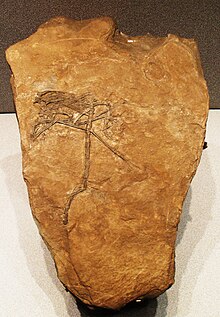Peteinosaurus
| Peteinosaurus | |
|---|---|

| |
| Paratype MCSNB 3359 | |
| Scientific classification | |
| Domain: | Eukaryota |
| Kingdom: | Animalia |
| Phylum: | Chordata |
| Order: | †Pterosauria |
| Clade: | †Eopterosauria |
| Genus: | †Peteinosaurus Wild, 1978 |
| Species: | †P. zambelli
|
| Binomial name | |
| †Peteinosaurus zambelli Wild, 1978
| |
Peteinosaurus (/pɛˌtaɪnəˈsɔːrəs/ peh-TY-nə-SOR-əs;[1] meaning "winged lizard") was a prehistoric genus of pterosaur. It lived in the late Triassic period in the late Norian age (about 218-215 million years ago),[2] and at a wingspan of around 60 cm (24 in), was one of the smallest and earliest pterosaurs,[3] although other estimates suggest a wingspan of up to 1 m (3.3 ft).[4]
Discovery

Three fossils have been found near Cene, Italy.[5] The first fossil, the holotype MCSNB 2886, is fragmentary and disarticulated. The second, the articulated paratype MCSNB 3359, lacks any diagnostic features of Peteinosaurus and thus might be a different species. This paratype has a long tail (20 cm) made more stiff by long extensions of the vertebrae; this feature is common among pterosaurs of the Triassic. The third example is MCSNB 3496, another fragmentary skeleton. All specimens are those of subadults and of none has the skull been preserved.
Like most pterosaurs, Peteinosaurus had bones that were strong but very light. Peteinosaurus is trimorphodontic, with three types of conical teeth. An insectivorous lifestyle has been attributed to Peteinosaurus.
The genus has been described by the German paleontologist Rupert Wild in 1978.[6] The type species is Peteinosaurus zambellii. The genus name is derived from Greek peteinos, "winged" and sauros, "lizard", the latter being used to indicate any saurian. The specific name, zambellii, honours Rocco Zambelli, the curator of the Bergamo natural history museum.
Classification
Peteinosaurus is one of the oldest-known pterosaurs, and at a mere sixty centimetres (24 in), had a tiny wingspan when compared to some later genera, such as Pteranodon whose wingspan exceeded twenty feet. Its wings were also proportionally smaller than those of later pterosaurs, as its wing length was only twice the length of the hindlimb.[5] All other known pterosaurs have wingspans at least three times the length of their hindlimbs.[5] It also had single cusped teeth that lacked the specialized heterodonty present in the other Italian Triassic pterosaur genus, Eudimorphodon.[5]
All these factors converge to hint that Peteinosaurus belongs to a group that possibly represents the most basal known pterosaurs: the
| Eopterosauria |
| ||||||||||||||||||||||||||||||||||||||||||
Mark Witton, however, considers Peteinosaurus to be a true dimorphodontid.
See also
References
- ^ Creisler, B. (2003). "Pterosauria Translation and Pronunciation Guide" Archived 2007-11-09 at the Wayback Machine, Dinosauria On-Line.
- ^ Müller R.T., Ezcurra M.D., Garcia M.S., Agnolín F.L., Stocker M.R., Novas F.E., Soares M.B., Kellner A.W.A. & Nesbitt S.J. (2023). ”New reptile shows dinosaurs and pterosaurs evolved among diverse precursors”. Nature 620(7974): p. 589–594. doi:10.1038/s41586-023-06359-z
- ^ Haines, Tim; Chambers, Paul (2005). The complete guide to prehistoric life.
- ISBN 9780231509411.
- ^ ISBN 1-84065-241-1.
- ^ Wild, R. (1978). "Die Flugsaurier (Reptilia, Pterosauria) aus der Oberen Trias von Cene bei Bergamo, Italien", Bolletino della Societa Paleontologica Italiana, 17 (2): 176-256.
- ISBN 0-7167-1822-7.
- ^ Andres, B., J. M. Clark, and X. Xu (2010). "A new rhamphorhynchid pterosaur from the Upper Jurassic of Xinjiang, China, and the phylogenetic relationships of basal pterosaurs", Journal of Vertebrate Paleontology 30 (1): 163-187.
- PMID 26339122.
- ^ Pterosaurs: Natural History, Evolution, Anatomy, 2013
- PMID 33005485.
